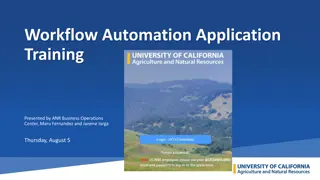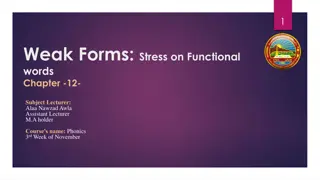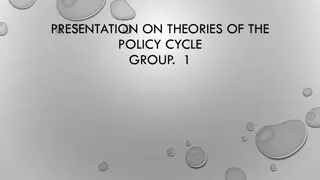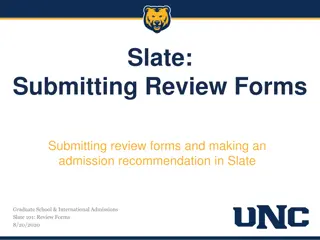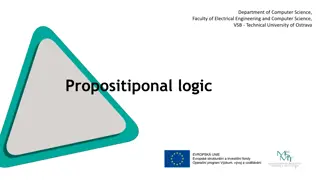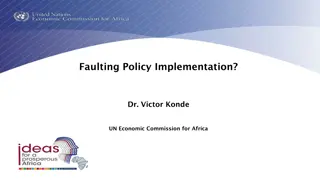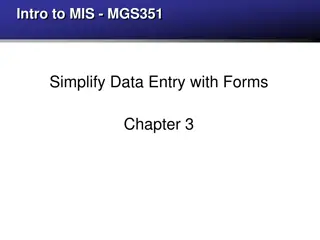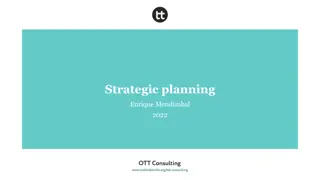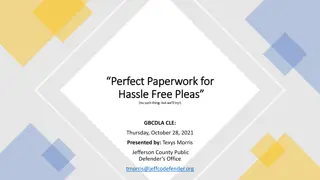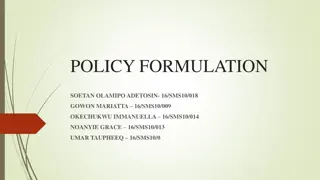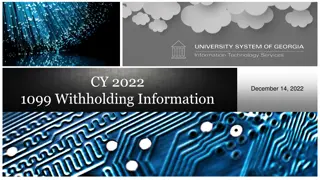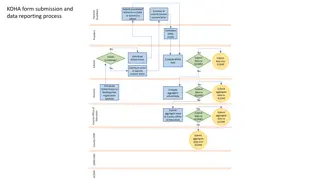
Understanding Adoption and Revision of ALTA Policies in 2021
Learn how new forms are adopted, who is involved in the process, reasons for revising the 2006 policies, and the changes made to address evolving legal landscapes like McGirt v. Oklahoma. Explore how industry stakeholders collaborate to ensure covered risks are addressed effectively.
Download Presentation

Please find below an Image/Link to download the presentation.
The content on the website is provided AS IS for your information and personal use only. It may not be sold, licensed, or shared on other websites without obtaining consent from the author. If you encounter any issues during the download, it is possible that the publisher has removed the file from their server.
You are allowed to download the files provided on this website for personal or commercial use, subject to the condition that they are used lawfully. All files are the property of their respective owners.
The content on the website is provided AS IS for your information and personal use only. It may not be sold, licensed, or shared on other websites without obtaining consent from the author.
E N D
Presentation Transcript
OVERVIEW How Do New Forms Get Adopted? Who Does the Work? Why Revise the 2006 Policies? What Changed in the Policies? ... and Endorsements, too!
HOW DO NEW FORMS GET ADOPTED? ALTA FORMS COMMITTEE Develop, Draft, Review, Refine, & Recommend ALTA BOARD OF GOVERNORS Formal Adoption THE PROCESS IS ONGOING It Begins With An Idea PUBLIC COMMENT PERIOD & REVIEW OF COMMENTS FINAL POSTING WITH EFFECTIVE DATE INDUSTRY IMPLEMENTATION
WHO DOES THE WORK? ALTA FORMS COMMITTEE 60+ Individual Title Underwriters Contributed 20+ Title Insurers Were Represented ALTA UNDERWRITER SECTION & SECTION EXECUTIVE COMMITTEE ALTA BOARD OF GOVERNORS INDUSTRY PARTNERS AND CUSTOMERS ACMA & ACREL FHFA, Fannie Mae, Freddie Mac MBA, Lenders
WHY REVISE THE 2006 POLICIES? Important laws, regulations, and some court decisions, too! Consumer Financial Protection Bureau Remote Online Notarization has become available in many jurisdictions
WHY REVISE THE 2006 POLICIES? McGirt v. Oklahoma, 140 S. Ct. 2452 (U.S. Sup. Ct., July 9, 2020) Operative Law Subcommittee Revisions Legislative-Regulatory-Judicial Focus on Discriminatory Covenants (e.g. Indiana HB 1314; 2020 Florida Legislation; 2020 Orange County, CA ALTA TitleNews Online, February 9, 2021; Washington HB 1335; May v. Spokane, (WA Ct. App.-Div. Three, Feb. 23, 2021) Existing Forms Subcommittee Revisions
WHY REVISE THE 2006 POLICIES? In the McGirt case, the Court held that the state of Oklahoma could not prosecute a Native American who allegedly committed a serious crime covered by a federal statute, finding that the statute gave only the federal government and the tribe concurrent jurisdiction within the boundaries of the tribal reservation which had not been disestablished The 2021 Policies include language clarifying the operative law to apply when interpreting policy provisions and determining rights and liabilities
COVERED RISK 2 (LP) & (OP) The Owner and Loan Policies update Covered Risk 2 by adding new examples of title defects that can cause a covered loss: a document affecting the Title not properly authorized, created, executed, witnessed, sealed, acknowledged, notarized, (including by remote online notarization), or delivered; and the repudiation of an electronic signature by a person who signed the document because the electronic signature was not valid under applicable electronic transactions law. The survey coverage provided by Covered Risk 2.c. is also enhanced to add a boundary line overlap as one of the matters covered if it would have shown up on a survey.
COVERED RISKS 5, 6, & 7 (LP) & (OP) Both the Owner and Loan Policies revise Covered Risks 5, 6 and 7 for loss resulting from a violation or enforcement of governmental regulations, enforcement of other governmental powers, or the exercise of the power of eminent domain. The updated language covers loss to the extent of the violation, enforcement or exercise described in an Enforcement Notice Enforcement Notice is a new defined term, and together with a refinement of the definition for Public Records, represents a significant clarification regarding the type of notice that triggers coverage and where that notice needs to be recorded.
COVERED RISK 8 (LP) & (OP) Both Policies add a new Covered Risk 8 that insures against enforcement of a PACA-PSA Trust to the extent described in an Enforcement Notice PACA-PSA Trust is also a new defined term The Perishable Agricultural Commodities Act (7 U.S.C. 499a, et seq.) imposes a trust for unpaid suppliers, sellers and agents of fresh fruits and fresh vegetables, The Packers and Stockyards Act (7 U.S.C. 181, et seq.) establishes a similar trust on assets of packers to protect livestock producers. Both trusts can exist in unrecorded form.
COVERED RISK 9 (LP) The 2021 Loan Policy updatesCovered Risk 9 by adding these new examples of matters that can impair the Insured Mortgage and cause a covered loss: the Insured Mortgage not being properly authorized, created, executed, witnessed, sealed, acknowledged, notarized (including by remote online notarization), or delivered; as well as the invalidity or unenforceability of Insured Mortgage resulting from the repudiation of an electronic signature by a person who signed the mortgage because the signature was not valid under applicable electronic transactions law.
COVERED RISK 10 (LP) Covered Risk 10 now explicitly insures the priority of the Insured Mortgage as to specific components of the Indebtedness, including: The amount of the principal disbursed as of the Date of Policy; the interest on the obligation secured by the Insured Mortgage; the reasonable expense of foreclosure; amounts advanced for insurance premiums by the Insured before the acquisition of the estate or interest in the Title; and the following amounts advanced by the Insured before the acquisition of the Title to protect the priority of the lien of the Insured Mortgage: i. real estate taxes and assessments imposed by a governmental taxing authority; and ii. regular, periodic assessments by a property owners association
COVERED RISKS 13(LP) & 9 (OP) There is new creditors rights coverage in Covered Risk 9 of the Owner Policy, and similar coverage in Covered Risk 13 of the Loan Policy The protection against loss resulting from a court order providing an alternative remedy now applies to both subsections of the Covered Risk. Section 550(a) of the Bankruptcy Code authorizes an alternative remedy in allowing the bankruptcy trustee to recover, for the benefit of the estate, the property transferred, or, if the court so orders, the value of such property In addition, the provision updates coverage by insuring against loss resulting from a prior transfer being voidable under the Uniform Voidable Transactions Act. The National Conference of Commissioners changed the Uniform Fraudulent Transfer Act to the Uniform Voidable Transactions Act in 2014
INTRODUCTION TO EXCLUSIONS Both the Owner and Loan Policies have two new Exclusions. The remaining changes to the Exclusions consist of updating and making them consistent with the revised language in the corresponding Covered Risks and the Conditions For example, in addition to excluding loss resulting from municipal regulations, Exclusion 1 revises subsection b. to exclude loss or damage resulting from any governmental forfeiture, police, regulatory, or national security power Exclusion 3.e. updates language to exclude loss or damage that would not have been sustained had the insured paid consideration sufficient to qualify as a bona fide purchaser or encumbrancer under applicable recording laws.
EXCLUSION 6 (LP) & 4 (OP) The creditors rights exclusion in each new policy contains a clarification that loss resulting from a voidable preference is excluded if not given as a contemporaneous exchange for new value Exclusion 4 in the Owner Policy and Exclusion 6 in the Loan Policy also contain an express exclusion for loss resulting from the transaction vesting the Title or creating the Insured Mortgage being a voidable transfer under the Uniform Voidable Transactions Act This reference to the Uniform Voidable Transactions Act, which has been adopted in at least 19 states, is intended to modernize the 2021 Policy forms
EXCLUSION 7 (LP) & 5 (OP) Both policies include a new exclusion for loss arising from any claim of a PACA-PSA Trust, while stating that the exclusion does not modify or limit the coverage provided by the new Covered risk 8. Covered Risk 8 in both policy forms insures against loss resulting from the enforcement of a PACA-PSA Trust, but only to the extent of the enforcement described in an Enforcement Notice.
EXCLUSION 7 (OP) & 9 (LP) Another new Exclusion 7 in the Owner Policy and new Exclusion 9 in the Loan Policy exclude loss caused by any discrepancy in the quantity of the area, square footage, or acreage of the Land or of any improvement to the Land.
SCHEDULE A (LP) & (OP) An optional Transaction Identification Data header has been added to Schedule A to provide clarity and make post-closing smoother and general inquiries easier to initiate This information is intentionally set apart from the insured information in Schedule A so it s not an insured matter but serves as reference information to improve communication Another optional provision enables the Schedule A to incorporate specific ALTA endorsements by reference. Reference can also be made to other available endorsements
SCHEDULE B (LP) & (OP) Schedule B begins with the following sentences: Some historical land records contain Discriminatory Covenants that are illegal and unenforceable by law. This policy treats any Discriminatory Covenant in a document referenced in Schedule B as if each Discriminatory Covenant is redacted, repudiated, removed, and not republished or recirculated. Only the remaining provisions of the document are excepted from coverage. This language obviates the need to add an exception for restrictions that may contain unenforceable discriminatory provisions. This provision would apply to all restrictions.
SCHEDULE B (LP) & (OP) The new Policies also revise the lead-in sentences immediately preceding the list of the exceptions The policy does not insure against loss or damage, and the Company will not pay costs, attorneys fees, or expenses resulting from the terms and conditions of any lease or easement identified in Schedule A, and the following matters: This addition obviates the need to include a specific exception in Schedule B for the terms and conditions of any leases or easements that comprise all or a part of the insured property
CONDITIONS There are several noteworthy revisions to the Conditions, beginning with the Definition of Terms in Condition 1 The terms Affiliate, Discriminatory Covenant, Enforcement Notice, PACA- PSA Trust and State are new in both policy forms Substantial revisions have been made to the terms Insured and Public Records
CONDITION 1.a. (LP) & (OP) In both policies an Affiliate is an Entity: that is wholly owned by the Insured; that wholly-owns the Insured; or if that Entity and the Insured are both wholly owned by the same person or entity. An Affiliate will be considered an Insured when the named Insured conveys the Title to the Affiliate by deed or other instrument of transfer
CONDITION 1.c. (LP) Definition of Consumer Protection Law The Loan Policy features a newly defined term for Consumer Protection Law, that replaces the terms consumer credit protection laws and truth in lending laws used in Exclusion 5 of the 2006 ALTA Loan Policy
CONDITION 1.e. (LP) & 1.d. (OP) Definition of Discriminatory Covenant
CONDITION 1.j. (LP) The new Loan Policy also makes changes to the definition of Insured. This additional language does not alter coverage but does clarify that the Insured is a person that holds the Title after acquiring the Indebtedness, regardless of the means of acquisition. In the Loan Policy, a transfer from the named insured to one of the following can also result in the grantee being an Insured under the policy: the grantee of an Insured under a deed or other instrument transferring the Title, if the grantee is an Affiliate (Note that this is no longer conditioned on the transfer being for no consideration); an Affiliate that acquires the Title through foreclosure or deed-in-lieu of foreclosure of the Insured Mortgage (regardless of whether the Affiliate owned or held the Indebtedness); or any Government Mortgage Agency or Instrumentality.
CONDITION 1.g. (OP) In the new Owner Policy, a deed from the named insured to one of the following can also result in the grantee being an Insured under the policy: a trustee or beneficiary of a trust created by a written instrument established for estate planning purposes by an Insured; a spouse who receives the Title because of a dissolution of marriage; a transferee by a transfer effective on the death of an Insured as authorized by law; or another Insured named in Item 1 of Schedule A. These last two categories are new. This provision differs from the corresponding language in the 2006 policy because there is no requirement that the deed or conveyance be for no consideration.
CONDITION 1.h. (LP) Definition of Government Mortgage Agency or Instrumentality The Loan Policy features a new defined term for Government Mortgage Agency or Instrumentality. The term that does not impact coverage, but is used in the definitions of Insured and Obligor A Government Mortgage Agency or Instrumentality is not an Obligor
CONDITION 1.p. (LP) Definition of Obligor The Loan Policy features a new defined term for Obligor, defined as a person or entity that is or becomes a maker, borrower, or guarantor as to all or part of the Indebtedness or other obligation secured by the Insured Mortgage. A Government Mortgage Agency or Instrumentality is not an Obligor The term Obligor is used primarily in Condition 12 of the Loan Policy, (Rights of Recovery upon Payment or Settlement) but Condition 12 of the 2006 and 2021 ALTA Loan Policy remain substantively the same
CONDITION 1.r. (LP) & 1.m. (OP) Definition of Public Records The 2021 ALTA policies modify the definition of Public Records The clarification distinguishes between those records that are Public Records for purposes of the title policy and other governmental records that are not intended to be, and are generally not construed as, within the scope of Public Records for purposes of triggering coverage in the policies
CONDITION 1.s. (LP) & 1.n. (OP) Definition of State The new polices include State as a new defined term. The inclusion makes it clear that term used in the policies means the state or commonwealth of the United States where the Land is located, and where applicable also includes the District of Columbia, the Commonwealth of Puerto Rico, the U.S. Virgin Islands, and Guam
CONDITION 8. (OP) & (LP) Condition 8, now entitled Contract of Indemnity; Determination and Extent of Liability contains some significant changes: The Condition clarifies that the policy is a contract of indemnity, with an initial statement that the policies are not abstracts of title, reports, legal opinions, opinions of title, or other representations of title Among the improvements in coverage are the provisions establishing a procedure for the Insured to select the date for determining value for purposes of calculating loss. The ability to choose an alternate date for the determination of loss is no longer conditioned on the Insurer s unsuccessful attempt to cure the defect
CONDITION 8. (LP) The new Loan Policy also provides options to the Insured for determining loss regardless of any actions taken on the part of the Insurer. Fair market value of the Title is calculated using either: the date the Insured acquires the Title as a result of a foreclosure or deed in lieu of foreclosure of the Insured Mortgage; or the date the lien of the Insured Mortgage or any assignment set forth in Item 4 of Schedule A is extinguished or rendered unenforceable by reason of a matter insured against by this policy. In addition, a new subsection provides additional alternatives to the Insured Claimant if the Insurer attempts to establish the Title but is unsuccessful: the Amount of Insurance will be increased by 15%; and the Insured Claimant may elect to use either the date the settlement, action, or proceeding is concluded or the date the notice of claim is received by the Insurer as the date for calculating the fair market value of the Title.
CONDITION 8. (OP) In the Owner Policy, while terms regarding the extent of liability remains essentially the same, a revised subsection addressing valuation states that the fair market value of the Title is calculated using the date the Insured discovers the defect or other matter insured against by this policy; however if, at the Date of Policy, the Title to all of the Land is void by reason of a matter covered by the policy, then the Insured Claimant may, by written notice given to the Insurer, elect to use the Date of Policy as the date for calculating the fair market value of the Title. If the Insurer does pursue its rights to cure the Title and is unsuccessful: the Amount of Insurance will be increased by 15% (an improvement from 10% in the 2006 policy); and the Insured Claimant may elect to use either the date the settlement, action, or proceeding is concluded or the date the notice of claim is received by the Insurer as the date for calculating the fair market value of the Title.
CONDITION 10 (LP) Condition 10 in the Loan Policy, now entitled Reduction or Termination of Insurance, improves the coverage in the Loan Policy by adding a new subsection b. that states: b. When the Title is acquired by the Insured as a result of foreclosure or deed in lieu of foreclosure, the amount credited against the Indebtedness does not reduce the Amount of Insurance.
CONDITION 15 (LP) & 16 (OP) The 2021 policies contain revised Choice of Law provisions. Condition 15.a. of the Loan Policy and 16.a. of the Owner Policy clearly provide that the State law of the State where the Land is located, or to the extent it controls, federal law, will determine the validity of claims against the Title or enforcement of the policy. While the provision is needed because of increased multi-state and cross- border transactions, the new reference to federal law addresses the jurisdictional issue raised in the McGirt decision.


